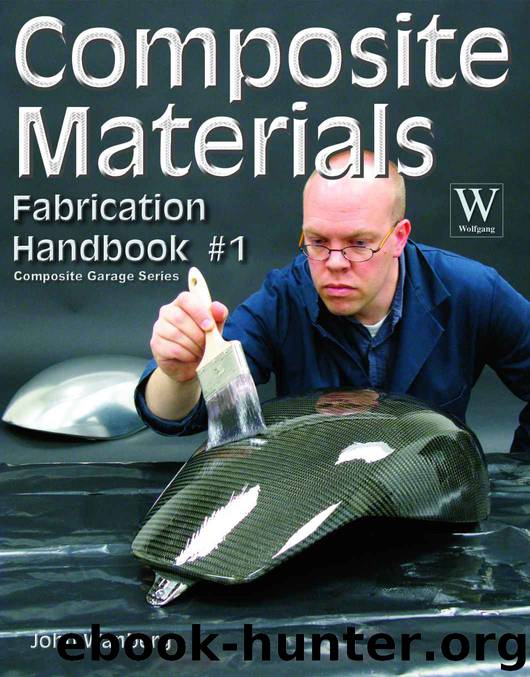Composite Materials Fabrication Handbook #1 (Composite Garage) by John Wanberg

Author:John Wanberg [Wanberg, John]
Language: eng
Format: azw3
Tags: Reference
Publisher: Wolfgang Publications
Published: 2017-03-27T04:00:00+00:00
Photo 17: Refillable aerosol sprayers can be filled with polyvinyl alcohol (PVA) for ease of application.
Photo 18: Spraying is the preferred method for applying PVA, especially if multiple coats are required.
Photo 19: PVA can also be applied by pouring it directly on or into a mold…
Photo 20: …and then wiped onto the mold surface completely and uniformly before it becomes tacky or dry.
Shield the mold from any dust or foreign matter (including curious fingers) that may otherwise damage the prepared mold surface. Use a painter’s drop cloth, such as an inexpensive polyethylene drop cloth, to protect the mold until all the materials for layup are ready.
BASIC PANEL LAMINATION USING A GEL/SURFACE COAT
Now that the mold is ready for layup, you can now begin to prepare a special surface protection, called a “gel coat” or “surface coat”. Some composites may experience environments that can cause excessive abrasion or where high humidity may produce fabric print-through. A composite may also require special coloring or surface effects. For these applications, a coating of resin is generally applied to the mold prior to the composite being laid over it. Such surface treatments are common in boats and hot tubs, but are also beneficial anywhere a durable surface is needed and the composite’s weight is not critical. These coatings generally add excess weight, and can be relatively brittle, yet are sought after when their advantages out-weigh their disadvantages. The term “gel coat” generally refers to special-purpose, gelled polyester resin coat, whereas a thickened epoxy resin coat is called a “surface coat”. Gel and surface coatings provide the best service when they actually cross-link with the composite laminate they are protecting. In this way they differ from a “flood coat” that is applied onto an already fully-cured composite (which will be discussed in the Finishing Techniques chapter).
The following directions include several general guidelines for mixing and using gel/surface coats. However, you should always read the instructions provided by your particular resin’s manufacturer. Whenever using polyester, vinylester, or polyester gel coat resins, make sure to mix them in a polyethylene, polypropylene, or unwaxed paper cup so the resin won’t dissolve the sides of the container; the styrene monomer in polyester and vinylester resins will attack any styrene based plastic and dissolve it (see photo 21). When mixing, always make sure to scrape the sides and bottom of the mixing container as much as possible during mixing so the resin and catalyst/hardener will be completely combined (see photo 22).
Download
This site does not store any files on its server. We only index and link to content provided by other sites. Please contact the content providers to delete copyright contents if any and email us, we'll remove relevant links or contents immediately.
| Automotive | Engineering |
| Transportation |
Machine Learning at Scale with H2O by Gregory Keys | David Whiting(3968)
Never by Ken Follett(3703)
Urban Outlaw by Magnus Walker(3305)
OPNsense Beginner to Professional by Julio Cesar Bueno de Camargo(3226)
Sapiens and Homo Deus by Yuval Noah Harari(2942)
Will by Will Smith(2735)
A Short History of Nearly Everything by Bryson Bill(2578)
Hooked: A Dark, Contemporary Romance (Never After Series) by Emily McIntire(2463)
Rationality by Steven Pinker(2228)
Borders by unknow(2143)
Holy Bible (NIV) by Zondervan(2055)
The Becoming by Nora Roberts(2031)
The One Percenter Encyclopedia by Bill Hayes(1754)
Freedom by Sonny Barger(1742)
HBR's 10 Must Reads 2022 by Harvard Business Review(1738)
A Short History of War by Jeremy Black(1724)
Five Ways to Fall by K.A. Tucker(1665)
Girls Auto Clinic Glove Box Guide by Patrice Banks(1654)
Go Tell the Bees That I Am Gone by Diana Gabaldon(1645)
